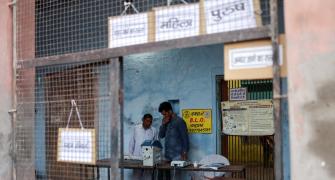It is an established fact that as an economy develops, it moves in to specialising in manufacturing from agriculture and later in to services including banking and other financial services.
In fact, India is passing through this transition phase accompanied with development of the financial sector thanks to the MNC banks that have entered the country. A recently released report on banking industry by PricewaterhouseCoopers (PwC) indicated that foreign banks are bullish about the Indian market.
The industry got wider attention as the report indicated that the banking sector is likely to grow significantly faster than the GDP of the E7 (India, China, Brazil, Russia, Indonesia, Turkey, and Mexico) countries as they develop. The report estimates that the total domestic advances in the E7 economies is likely to overtake total domestic credit offtake in the G7 economies within the next 40 years.
Significantly, the report states that India is likely to emerge as the third largest domestic banking market in the world by 2040 and could grow faster than China in the long run.
Even before this was revealed by the above recently released report, many of the foreign banks have set up shops in India and in the process bringing in global business practices and domesticated global financial products. That was a wake up alarm for the domestic banks to spruce up themselves.
The report identified demographics, the economic cycle, politics, regulation and reporting, and technology as the five principal drivers of growth of banking industry in these countries. With the industry is in the transition stage, let us focus on regulatory issues that would decide its future growth prospects.
Tougher competition, stricter regulations, continued privatization, slow infusion of global norms and high profile business failures have put traditionally conservative public sector banks under constant pressure to perform better while effectively managing their business risk.
To sustain in the business, it is essential that they are aware of various risks such as credit, interest rate, foreign exchange, and liquidity risks along with appropriate avenues to mitigate them.
Risk management is often a highly complex process requiring sophisticated tools and techniques to operate within the existing regulatory requirements. Basel II norms have come into existence, in an effort to implement global banking norms to facilitate the globalization of the industry in line with the major role of central banks to infuse global economic stability.
What is Basel II? Simply put, Basel II is the new international capital regulation, which seeks to promote banking and financial sector to avoid financial disaster and thereby providing economic stability.
Basel II provides various guidelines with regard to credit, market and operational risk measurement in the banking industry and a bank in compliance with Basel II norms would be in a position to better understand, monitor and manage its credit risk exposure.
Though in India, as per the regulatory requirements, only banks receiving more than 20 per cent of their businesses from abroad would have to implement Basel II norms, most other banks have shown interests in implementing Basel II norms in a phased manner.
The three pillars of Basel II are minimum capital requirement, supervisory review process, and market discipline requirements (improved transparency, effective risk management, sound financial system, etc.)
One of the critical success factors for a bank under Basel II would remain risk identification/ measurement/mitigation and minimum capital allocation. Typically, a bank would face three types of risks; operational risk, credit risk and market risk.
The advent of derivatives trading in India has thrown doors open enormous opportunities to manage some of these risks. Commodity derivatives are another such avenue that banks could tap in an attempt to adhere to Basel II norms.
But, the path for the banks to comply with Basel II norms is being made arduous by the increasing customer base, growing product profiles, lack of effective risk management tools, impending regulatory reforms, etc. For example, existing regulatory norms allow aggregate exposure of any given bank to capital markets not exceeding 40 per cent of its net worth.
To mitigate the risks involved in capital markets, it would be a best practice on the part of the commercial banks to avail various opportunities and derivative instruments in a systematic way to mitigate their risk within their own constraints and regulatory norms.
In the same way, if banks are allowed to operate in commodity derivatives market within a set of regulations, it would lend more balance and would help in propping up its portfolio of investments and spread its risk various asset classes.
In fact, extensive use of derivatives by banks as an evolving phenomenon has recently been reported in the international media, of which a larger part has been held by them to manage their own risk.
For instance, available statistics suggest that participation by banks in derivative markets had increased dramatically during the past decade, rising from notional amounts of $7.34 trillion as on December 31, 1991, to about $ 84.18 trillion by September 30, 2004.
By the very nature of the operation of the Indian banks it is inevitable that they are exposed to several risks such as interest rate risk, foreign exchange risk, commodity price risk and the resultant credit default risk. All these risks in one way or the other are manageable by sharing it across the ecosystem by way of participation in the derivative markets with varied underlying.
An analysis of outstanding operating credit of Indian banks to different industries had revealed that on the average banks might tend to loose 23 percent of their aggregate lending based on the annualized volatility in the commodities of importance to these industries.
Further, it has been found out that in select stocks of companies with intense exposure to primary commodities, which are traded on the commodity exchange platform there is an inverse relationship in their price movement indicating an opportunity for the banks who had invested on those stocks to hedge their exposure on the related commodity derivatives.
An analysis of the relationship between the select stocks and the related commodity prices on the commodity markets reveal a high degree of relationship between their basic raw material prices and stock prices.
This high correlation between equity prices and the prices of the underlying commodities (in which they primarily deal with) such as the MCX platform as shown in the table provides an opportunity for the equity market players including banks and funds to hedge their risk by taking relevant positions simultaneously in both the equity and commodity futures market.
Banks apart from funds with their connectivity to customers shall also act as market access providers to the common man and small producers in the commodity derivatives market which would not only provide a business opportunity but also contribute to the central banks basic role of infusing economic stability.
Further, a comparative analysis of the average daily volatility of MCX comdex and NSE S&P Nifty (as provided in Table II), MCX Comdex (indicative commodity futures prices) is much more stable than NSE Nifty (equity market).
This makes a strong case for banks to be allowed in commodity markets when they are allowed in equity markets, as commodities are less risk prone and are tightly regulated despite the high leverage.
A comparison of the regulatory tools and principles, business practices, and rules and regulations of the domestic stock and commodity exchanges vindicates that both commodity and stock exchanges are regulated professionally with the same set of principles and under the same spirit.
Hence, there are no reasons for the banks to be kept away from an existing opportunity to effectively mitigate direct or indirect risks associated with commodity price volatility.
An early action to allow domestic banks to participate in the commodity markets would not only help in improving their competency but would also help in develop their trading and product development skills in commodity derivatives in line with the international banks operating in India but would also enable them to effectively adhere to the Basel II norms by managing their risks effectively.
Authors are Chief Economist and Economist, Multi Commodity Exchange of India Limited (MCX).







